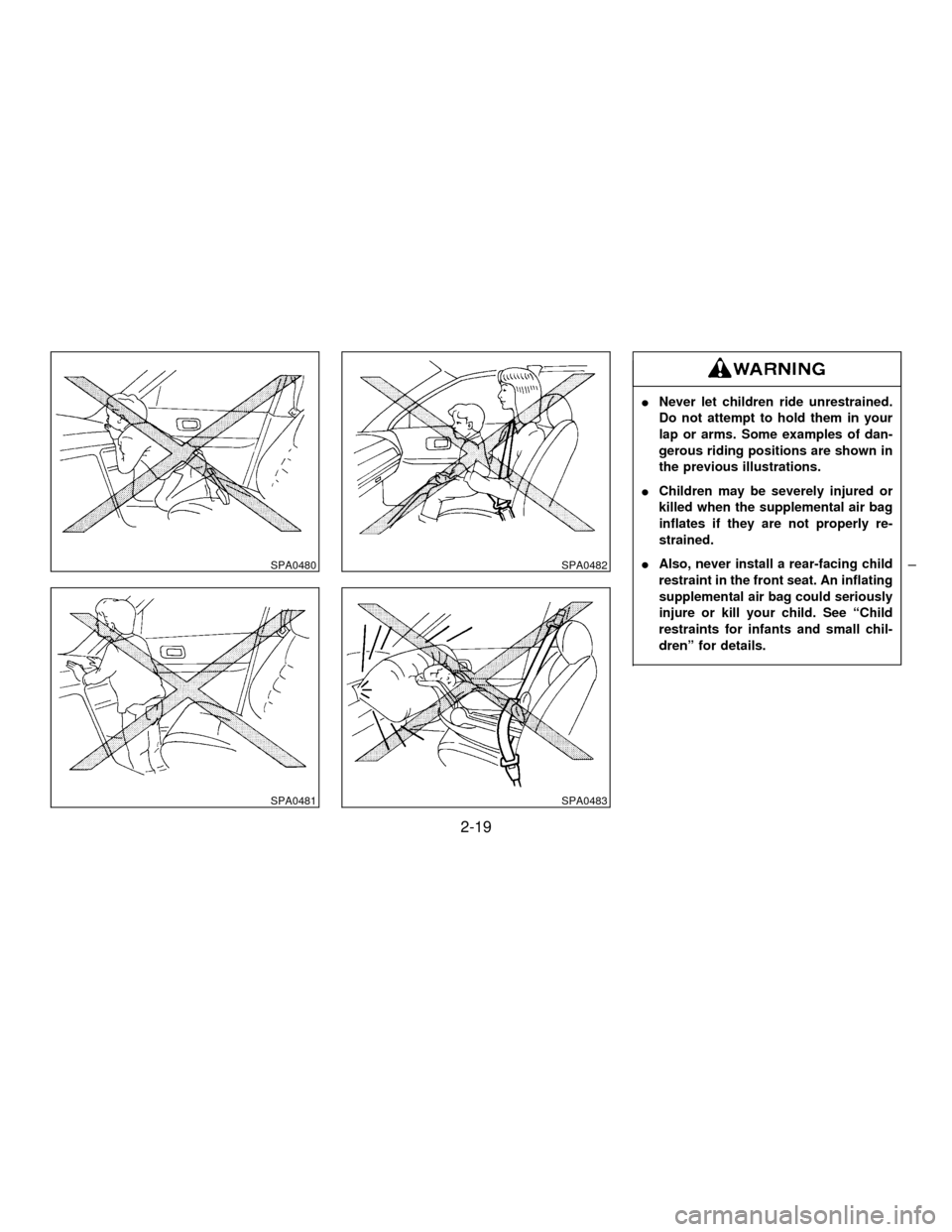NISSAN MAXIMA 1997 A32 / 4.G Workshop Manual
Manufacturer: NISSAN, Model Year: 1997, Model line: MAXIMA, Model: NISSAN MAXIMA 1997 A32 / 4.GPages: 215, PDF Size: 1.75 MB
Page 51 of 215

against it when it inflates. Always sit
back against the seatback and as far
away as practical from the steering
wheel or instrument panel. Always
use the seat belts.
IKeep hands on the outside of the
steering wheel. Placing them inside
the steering wheel rim could increase
the risk that they are injured when the
supplemental air bag inflates.
SPA0476SPA0477SPA0478
SPA0479
2-18
Z01.2.1/A32-DX
Page 52 of 215

INever let children ride unrestrained.
Do not attempt to hold them in your
lap or arms. Some examples of dan-
gerous riding positions are shown in
the previous illustrations.
IChildren may be severely injured or
killed when the supplemental air bag
inflates if they are not properly re-
strained.
IAlso, never install a rear-facing child
restraint in the front seat. An inflating
supplemental air bag could seriously
injure or kill your child. See ªChild
restraints for infants and small chil-
drenº for details.
SPA0480
SPA0481
SPA0482
SPA0483
2-19
Z01.2.1/A32-DX
Page 53 of 215

Supplemental air bag system
The driver supplemental air bag is located in
the center of the steering wheel; the front
passenger supplemental air bag is mounted in
the dashboard above the glove box. The
supplemental air bag system is designed to
inflate in higher severity frontal collisions, al-
though it may inflate if the forces in another
type of collision are similar to those of a higher
severity frontal impact. It may not inflate in
certain frontal collisions. Vehicle damage (or
lack of it) is not always an indication of proper
supplemental air bag operation.
When the supplemental air bag inflates, a fairlyloud noise may be heard, followed by release
of smoke. This smoke is not harmful and does
not indicate a fire, but care should be taken not
to intentionally inhale it, as it may cause irrita-
tion and choking. Those with a history of
breathing trouble should get fresh air promptly.
Supplemental air bags, along with the use of
seat belts, help to cushion the impact force on
the face and chest of the occupant. They can
help save lives and reduce serious injuries.
However, an inflating supplemental air bag
may cause facial abrasions or other injuries.
Supplemental air bags do not provide restraint
to the lower body.The seat belts should be correctly worn and
the driver and passenger seated upright as far
as practical away from the steering wheel or
dashboard. Since the supplemental air bag
inflates quickly in order to help protect the
occupant, the force of the supplemental air
bag inflating can increase the risk of injury if
the occupant is too close to or is against the
supplemental air bag module during inflation.
The supplemental air bag will deflate quickly
after a collision.
After turning the ignition key to the ªONº
position, the supplemental air bag warning
light illuminates. The supplemental air bag
warning light will turn off after about 7
seconds if the system is operational.
IDo not place any objects on the steer-
ing wheel pad or on the instrument
panel. Also, do not place any objects
between any occupant and the steer-
ing wheel or instrument panel. Such
objects may become dangerous pro-
jectiles and cause injury if the supple-
mental air bag inflates.
IRight after inflation, several supple-
SPA0103A
2-20
Z01.2.1/A32-DX
Page 54 of 215

mental air bag system components
will be hot. Do not touch them; you
may severely burn yourself.
INo unauthorized changes should be
made to any components or wiring of
the supplemental air bag system.
This is to prevent accidental inflation
of the supplemental air bag or dam-
age to the supplemental air bag sys-
tem.
IDo not make unauthorized changes
to your vehicle's electrical system,
suspension system or front end
structure. This could affect proper
operation of the supplemental air bag
system.
ITampering with the supplemental air
bag system may result in serious
personal injury. Tampering includes
changes to the steering wheel and
the instrument panel assembly by
placing material over the steering
wheel pad and above the dashboard,
or by installing additional trim mate-
rial around the supplemental air bag
system.IWork around and on the supplemen-
tal air bag system should be done by
an authorized NISSAN dealer. Instal-
lation of electrical equipment should
also be done by an authorized
NISSAN dealer. The SRS wiring har-
nesses should not be modified or
disconnected. Unauthorized electri-
cal test equipment and probing de-
vices should not be used on the
supplemental air bag system.
IThe SRS wiring harnesses are cov-
ered with yellow insulation either just
before the harness connectors or for
the complete harness, for easy
identification.
When selling your vehicle, we request that you
inform the buyer about the supplemental air
bag system and guide the buyer to the appro-
priate sections in this Owner's Manual.
2-21
Z01.2.1/A32-DX
Page 55 of 215

Warning labels about the supplemental air bag
system are placed in the vehicle.The supplemental air bag light, displaying ªAIR
BAGº in the instrument panel, monitors the
circuits of the supplemental air bag. The cir-
cuits monitored by the supplemental air bag
light are the diagnosis sensor unit, supplemen-
tal air bag modules and all related wiring.
When the ignition key is in the ªONº or
ªSTARTº position, the supplemental air bag
light will illuminate for about 7 seconds and
then turn off. This means the system is opera-
tional.
SPA0104ASPA0105
SUPPLEMENTAL AIR BAG
WARNING LABELSSUPPLEMENTAL AIR BAG
WARNING LIGHT
2-22
Z01.2.1/A32-DX
Page 56 of 215

If any of the following conditions occurs, the
supplemental air bag needs servicing:
1. The supplemental air bag light goes off
within 7 seconds.
2. The supplemental air bag light flashes in-
termittently or remains on (after 7 seconds).
3. The supplemental air bag light does not
come on at all.
Under these conditions, the Supplemental Re-
straint System Air Bag may not operate prop-
erly. It must be checked and repaired.
Take your vehicle to the nearest authorized
NISSAN dealer.
If the supplemental air bag warning light
is on, it could mean that the supplemen-
tal air bag will not operate in an
accident.
Repair and replacement procedure
The supplemental air bag system is designed
to inflate on a one-time-only basis. As a re-
minder, unless it is damaged, the supplemen-
tal air bag light will remain illuminated afterinflation has occurred. Repair and replace-
ment of the supplemental air bag system
should be done only by authorized NISSAN
dealers.
To ensure long-term functioning, the sys-
tem must be inspected 10 years after the
date of manufacture noted on the certifica-
tion label located on the driver side center
pillar.
When maintenance work is required on the
vehicle, the supplemental air bag system and
related parts should be pointed out to the
person conducting the maintenance. The igni-
tion key should always be in the ªLOCKº
position when working under the hood or in-
side the vehicle.
IOnce the supplemental air bag has
inflated, the supplemental air bag
module will not function again and
must be replaced. The supplemental
air bag module should be replaced by
an authorized NISSAN dealer. The
supplemental air bag module cannot
be repaired.
IThe supplemental air bag systemshould be inspected by an authorized
NISSAN dealer if there is any damage
to the front end portion of the vehicle.
IIf you need to dispose of a supple-
mental air bag or scrap the vehicle,
contact an authorized NISSAN dealer.
Correct supplemental air bag dis-
posal procedures are set forth in the
appropriate NISSAN Service Manual.
Incorrect disposal procedures could
cause personal injury.
2-23
Z01.2.1/A32-DX
Page 57 of 215

PRECAUTIONS ON SEAT BELT
USAGE
Your chances of being injured or killed in an
accident and/or the severity of injury may be
greatly reduced if you are wearing your seat
belt and it is properly adjusted. NISSAN
strongly encourages you and all of your pas-
sengers to buckle up every time you drive,
even if your seating position includes a supple-
mental air bag.
Some states, provinces or territories re-
quire that seat belts be worn at all times
when a vehicle is being driven.
IEvery person who drives or rides in
this vehicle should use a seat belt at
all times. Children should be properly
restrained and, if appropriate, in a
child restraint.
IThe belt should be adjusted properly
and to a snug fit. Failure to do so may
reduce the effectiveness of the entire
restraint system and increase the
chance or severity of injury in an
accident. Serious injury or death can
occur if the seat belt is not worn
properly.
IAlways route the shoulder belt over
your shoulder and across your chest.
Never run the belt behind your backs
under your arm or across your neck.
The belt should be away from your
face and neck, but not falling off your
shoulder.
IPosition the lap belt as low and snug
SPA0506SPA0485
SEAT BELTS
2-24
Z01.2.1/A32-DX
Page 58 of 215

as possible AROUND THE HIPS, NOT
THE WAIST. A lap belt worn too high
could increase the risk of internal
injuries in an accident.
IBe sure the seat belt tongue is se-
curely fastened to the proper buckle.
IDo not wear the belt inside out or
twisted. Doing so may reduce its ef-
fectiveness.
IDo not allow more than one person to
use the same belt.
INever carry more people in the ve-
hicle than there are seat belts.
IIf the seat belt warning lamp glows
continuously while the ignition is
turned ªONº with all doors closed
and all seat belts fastened, it may
indicate a malfunction in the system.
Have the system checked by your
NISSAN dealer.
IAll seat belt assemblies including re-
tractors and attaching hardware
should be inspected by your NISSAN
dealer after any collision. NISSAN
recommends that all seat belt assem-
blies in use during a collision be
replaced unless the collision was mi-
nor and the belts show no damage
and continue to operate properly.
Seat belt assemblies not in use dur-
ing a collision should also be in-
spected and replaced if either dam-
age or improper operation is noted.
CHILD SAFETY
Children need adults to help protect them.
Infants and children need special pro-
tection. The vehicle's seat belts may not
fit them properly. The shoulder belt may
come too close to the face or neck. The
lap belt may not fit over their small hip
bones. In an accident, an improperly
fitting seat belt could cause serious or
fatal injury. Always use appropriate
child restraints.
All U.S. states and provinces of Canada re-
quire the use of approved child restraints for
infants and small children. (See ªChild re-
straints for infants and small childrenº later in
this section.)
In addition, there are many types of child
restraints available for larger children which
should be used for maximum protection.
Infant or small child
NISSAN recommends that infants or small
children be placed in child restraints that com-
ply with Federal Motor Vehicle Safety Stan-
dards or Canadian Motor Vehicle Safety Stan-
dards. You should choose a child restraint that
fits your vehicle and always follow the manu-
SPA0486
2-25
Z01.2.1/A32-DX
Page 59 of 215

facturer's instructions for installation and use.
Children
Children who are too large for child restraint
systems should be seated and restrained by
the seat belts which are provided.
NISSAN recommends that children sit in the
rear seat if possible. According to accident
statistics, children are safer when properly
restrained in the rear seat than in the front
seat.
If the child's seating position has a shoulder
belt that fits close to the face or neck, the use
of a booster seat (commercially available) may
help overcome this. The booster seat should
raise the child so that the shoulder belt is
properly positioned across the top, middle
portion of the shoulder and the lap belt is low
on the hips. The booster seat should fit the
vehicle seat and have a label certifying that it
complies with Federal Motor Vehicle Safety
Standards or Canadian Motor Vehicle Safety
Standards. Once the child has grown so the
shoulder belt is no longer on or near the face
and neck, use the shoulder belt without the
booster seat.Never let a child stand or kneel on any
seat and do not allow a child in the cargo
areas while the vehicle is moving. The
child could be seriously injured or killed
in an accident.
PREGNANT WOMEN
NISSAN recommends that pregnant women
use seat belts. Contact your doctor for specific
recommendations. The lap belt should be
worn snug and positioned as low as possible
around the hips, not the waist.
INJURED PERSONS
NISSAN recommends that injured persons
use seat belts, depending on the injury. Check
with your doctor for specific recommendations.
3-POINT TYPE SEAT BELT WITH
RETRACTOR
Every person who drives or rides in this
vehicle should wear a seat belt at all
times.
Fastening the belts
1. Adjust the seat.
SPA0492
2-26
Z01.2.1/A32-DX
Page 60 of 215

Do not ride in a moving vehicle when the
seatback is reclined. This can be dan-
gerous. The shoulder belt will not be
against your body. In an accident you
could be thrown into it and receive neck
or other serious injuries. You could also
slide under the lap belt and receive se-
rious internal injuries.
For most effective protection when the
vehicle is in motion, the seat should be
upright. Always sit well back in the seatand adjust the seat belt properly.
2. Slowly pull the seat belt out of the retractor
and insert the tongue into the buckle until it
snaps.
The retractor is designed to lock during a
sudden stop or on impact. A slow pulling
motion will permit the belt to move, and
allow you some freedom of movement in
the seat.
3. Position the lap belt portionlow and snug
on the hipsas shown.
4. Pull the shoulder belt portion toward the
retractor to take up extra slack.
The front passenger side seat belt and rear
SPA0493PD1024M
2-27
Z01.2.1/A32-DX